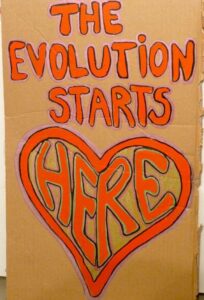
We often imagine revolution as a sudden explosion—a single, dramatic event that topples governments and reshapes society in an instant. It’s a romantic notion, fuelled by stories of uprisings and revolts that seem to erupt out of nowhere. But when you look closer at history and the way social change really happens, you start to see that revolution is far from a spontaneous event. Instead, it’s the boiling point of a much longer, slower process of evolution. For anarchists, who envision a world free from hierarchy, violence, and oppression, understanding this dynamic is key to building meaningful, lasting change.
At its core, every society is built on a set of ideas—ideas about power, authority, value, and the way we relate to each other. These ideas underpin the entire structure, from governments and institutions down to everyday interactions. To change that structure, the ideas themselves need to change first. This is why anarchism focuses so heavily on raising consciousness, on education, and on challenging the deeply ingrained beliefs that keep the current system in place. Without a shift in how people think, any attempt at social revolution is doomed to replicate the same oppressive patterns that anarchists seek to dismantle.
The first thing to understand about social revolution is that it’s not an accident. It’s not something that can be manufactured out of thin air. Revolution is the product of a long-term, cumulative process of evolution—what we might call social evolution. This process is gradual, and it often goes unnoticed until it reaches a critical point. Just as plants take time to grow, ideas about justice, freedom, and solidarity also grow slowly, bit by bit. They spread through conversations, education, organizing, and lived experiences. As these ideas take root, they begin to challenge the dominant narratives that have kept the current power structures intact for so long.
When enough people embrace these new ideas and become committed to putting them into practice, that’s when things start to heat up. Evolution accelerates. People demand changes to the way society operates, and those in power push back, determined to maintain their control. It’s at this point, when peaceful calls for reform are met with resistance, that evolution can transition into revolution.
This is an important distinction: evolution and revolution are not two separate phenomena. They are part of the same continuum. Revolution is simply evolution at its most intense, at its boiling point. Just as water boils when it reaches a certain temperature, social movements reach their boiling point when the collective desire for change becomes unstoppable.
It’s also important to note that revolution cannot be forced. Just as you can’t rush a pot of water to boil by willing it to happen, you can’t artificially create a revolution by sheer force of will. The conditions need to be right. The ideas need to have spread. The discontent needs to have reached a tipping point. And the will for change must be strong enough to overcome the forces that resist it. Revolution is the natural outcome of a fire that has been burning steadily for a long time—it’s the moment when that fire becomes too strong for the current system to withstand.
In Aotearoa, as in many parts of the world, we’re living through a time of social evolution. Conversations about decolonization, environmental justice, economic inequality, and indigenous sovereignty are challenging the status quo. These are not new ideas, but they are gaining traction, and the ground is shifting beneath the feet of those who hold power.
The question for anarchists, then, is how do we nurture this process? How do we continue to build the fire of evolution, so that when the time comes, revolution will be the natural outcome? This doesn’t mean forcing a violent overthrow of the state or rushing into chaotic confrontations. Instead, it means laying the groundwork—supporting the movements that are pushing for justice, amplifying the voices of those who are most marginalized, and organizing our communities to be resilient and self-sufficient.
Anarchism has always been about more than just tearing down oppressive structures. It’s about building something better in their place. Revolution, when it comes, should not be a moment of destruction for its own sake. It should be the culmination of years of organizing, learning, and growing—a moment when the people, empowered by their collective strength, reclaim the power that has been denied to them for so long. It’s the point at which the fire of evolution has burned so brightly that the old structures can no longer contain it.
But revolution is not the beginning of social change—it’s the result. The real work happens long before that moment, in the everyday acts of resistance, education, and solidarity that push society toward a new understanding of what’s possible. In this sense, the quiet work of social evolution is just as important, if not more so, than the explosive moment of revolution. Evolution is what lays the foundation for a new world, while revolution is simply the final push that brings that world into being.
For those of us committed to a non-violent, egalitarian society, the path ahead is clear. We must continue the work of building the conditions for social evolution. This means challenging oppressive systems in our everyday lives, creating spaces where new ideas can flourish, and preparing our communities for the moment when evolution becomes revolution.
Revolution will come, but it won’t come by force. It will come as a natural result of the slow, steady fire that we are building together. And when it does, it will be a reflection of the collective power of people who have had enough of the old way and are ready to embrace something new.
Let’s keep stoking the fire. Let’s keep pushing the evolution. When the time is right, the revolution will follow.